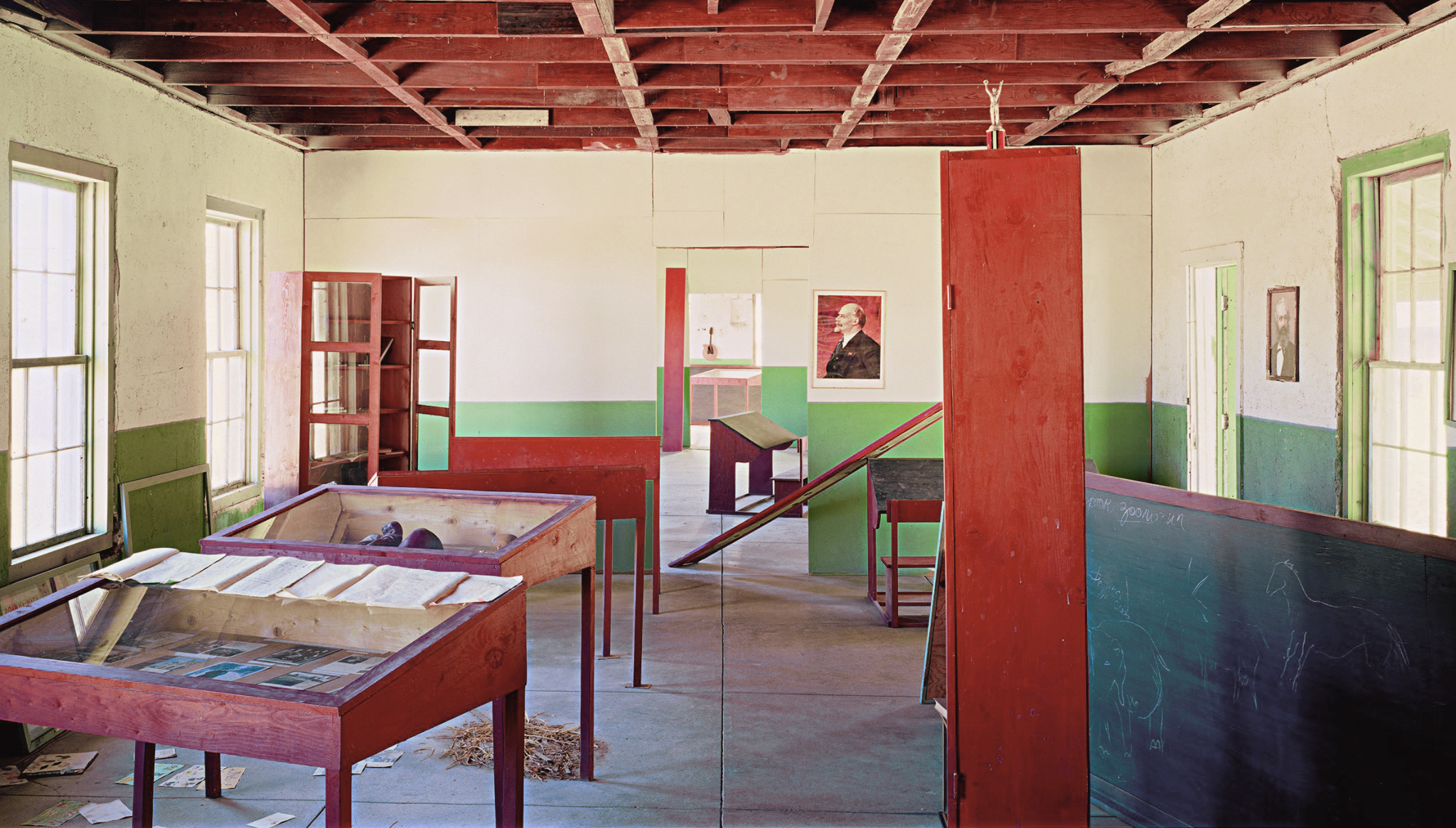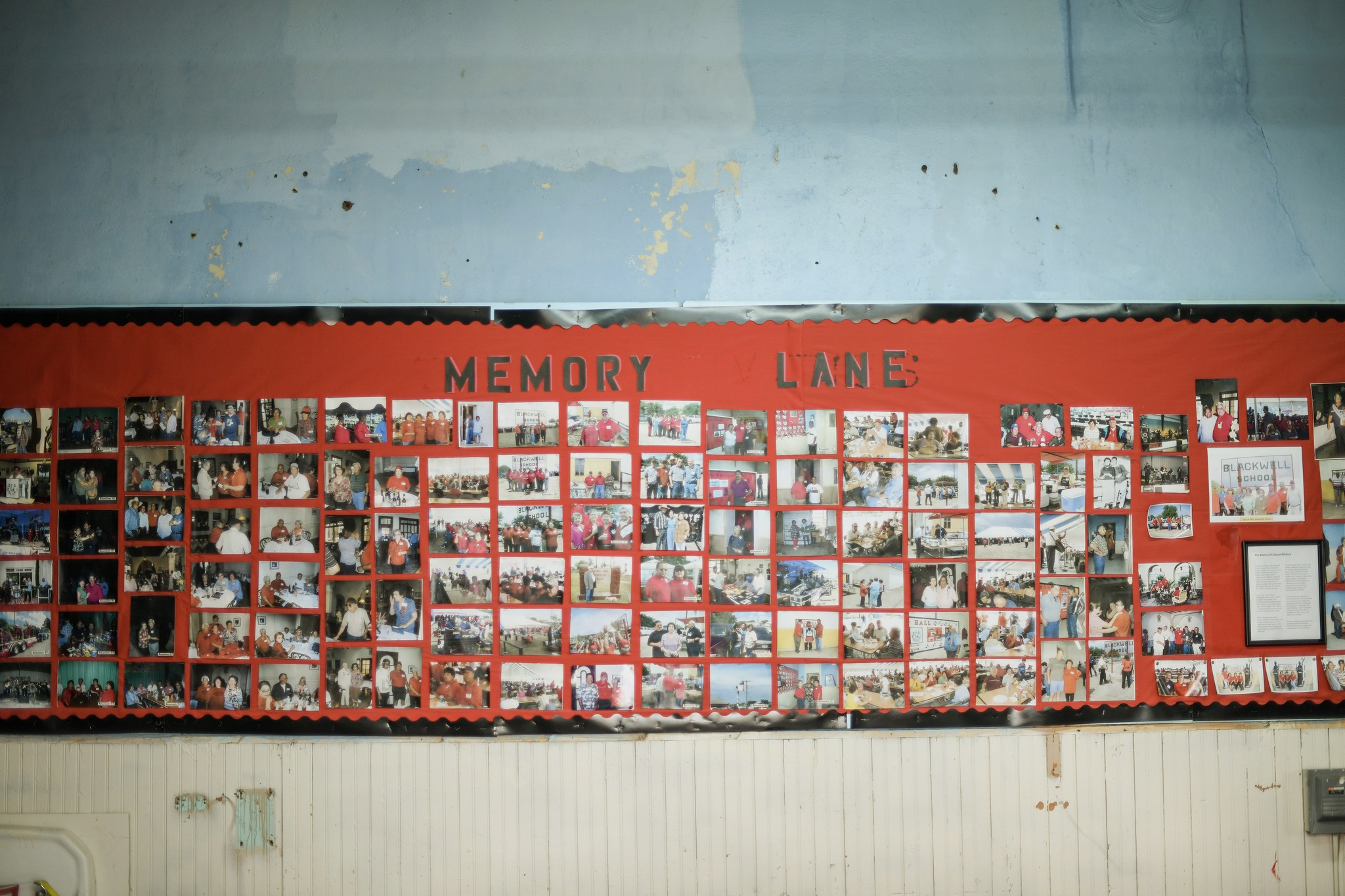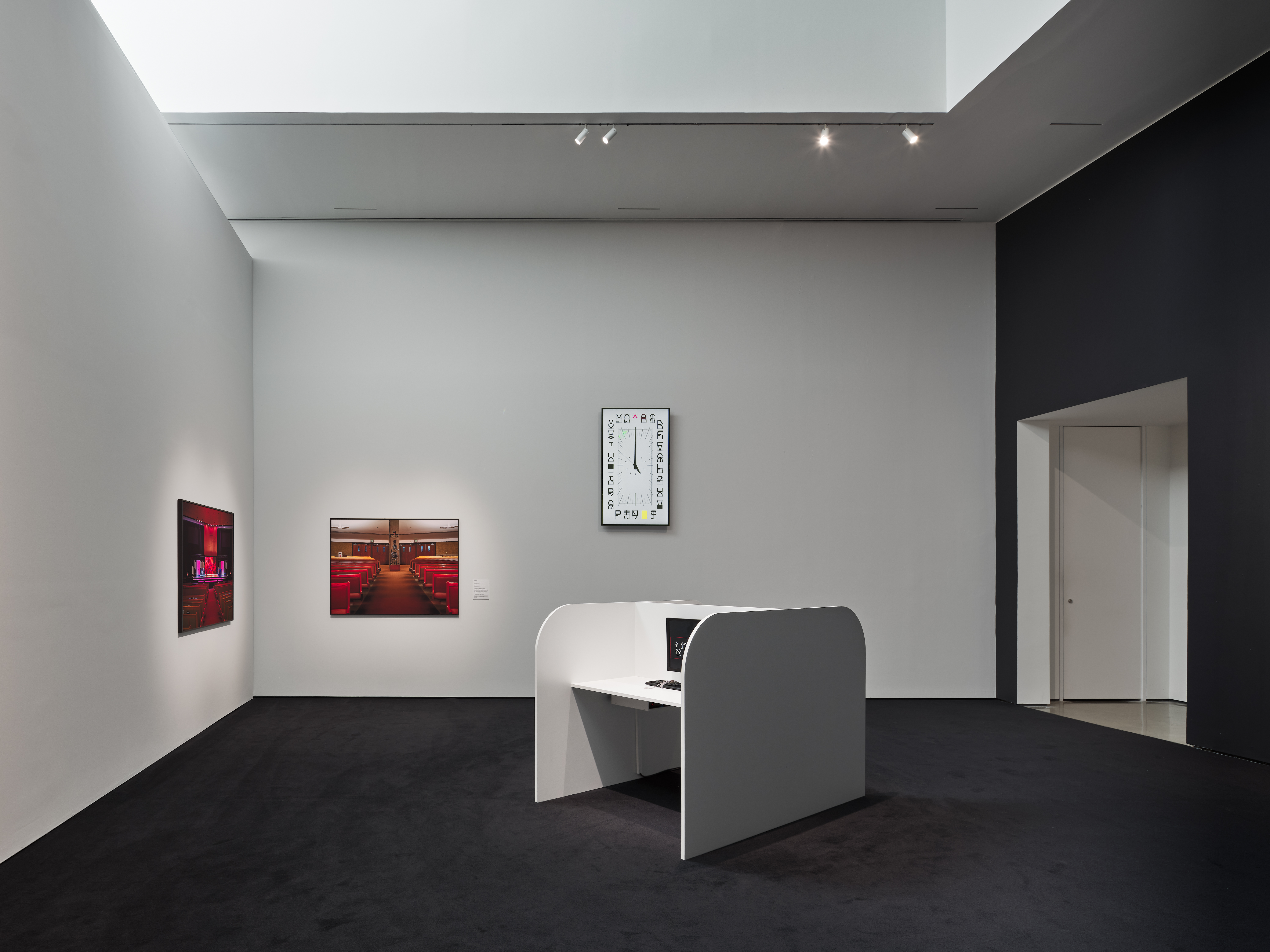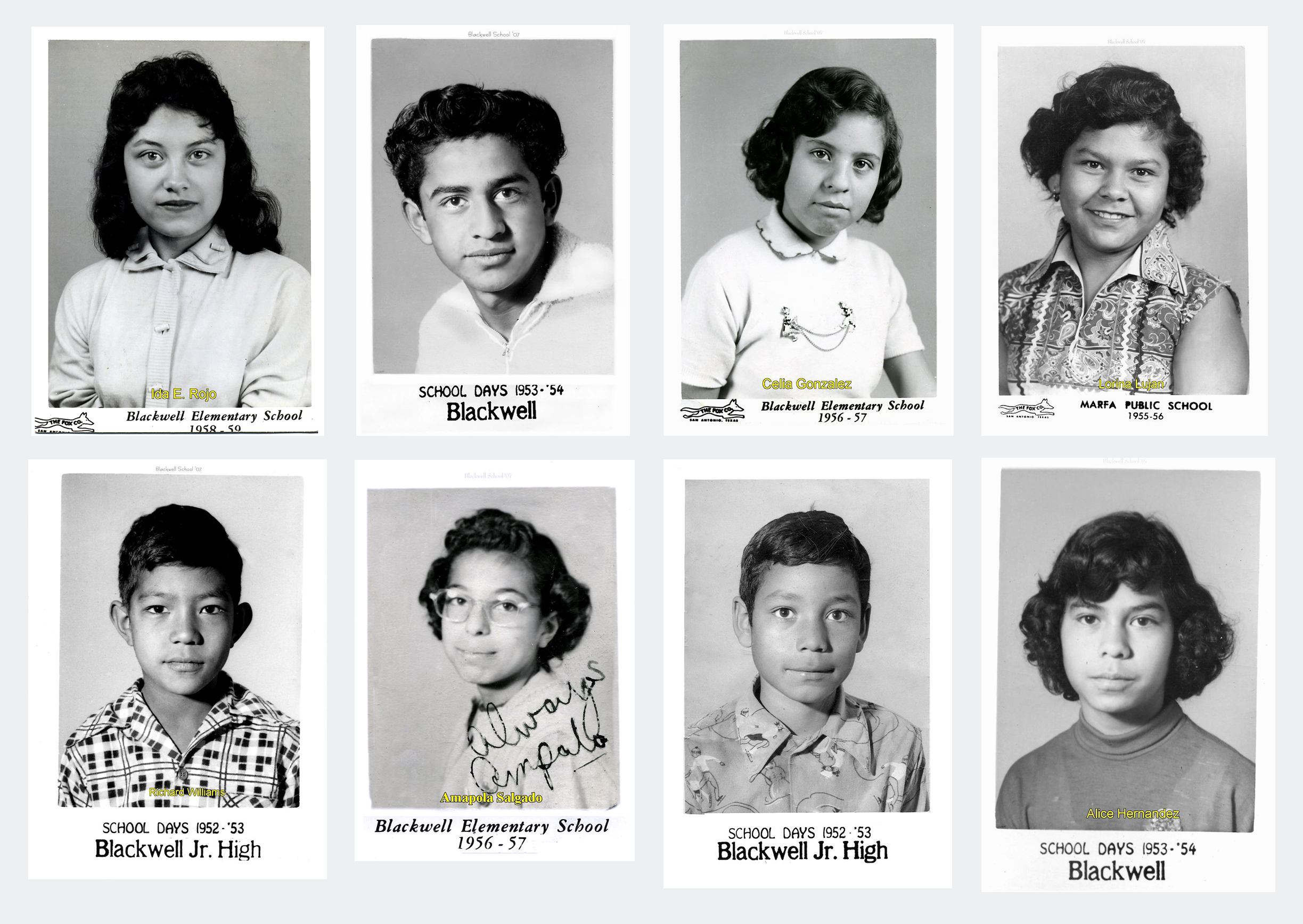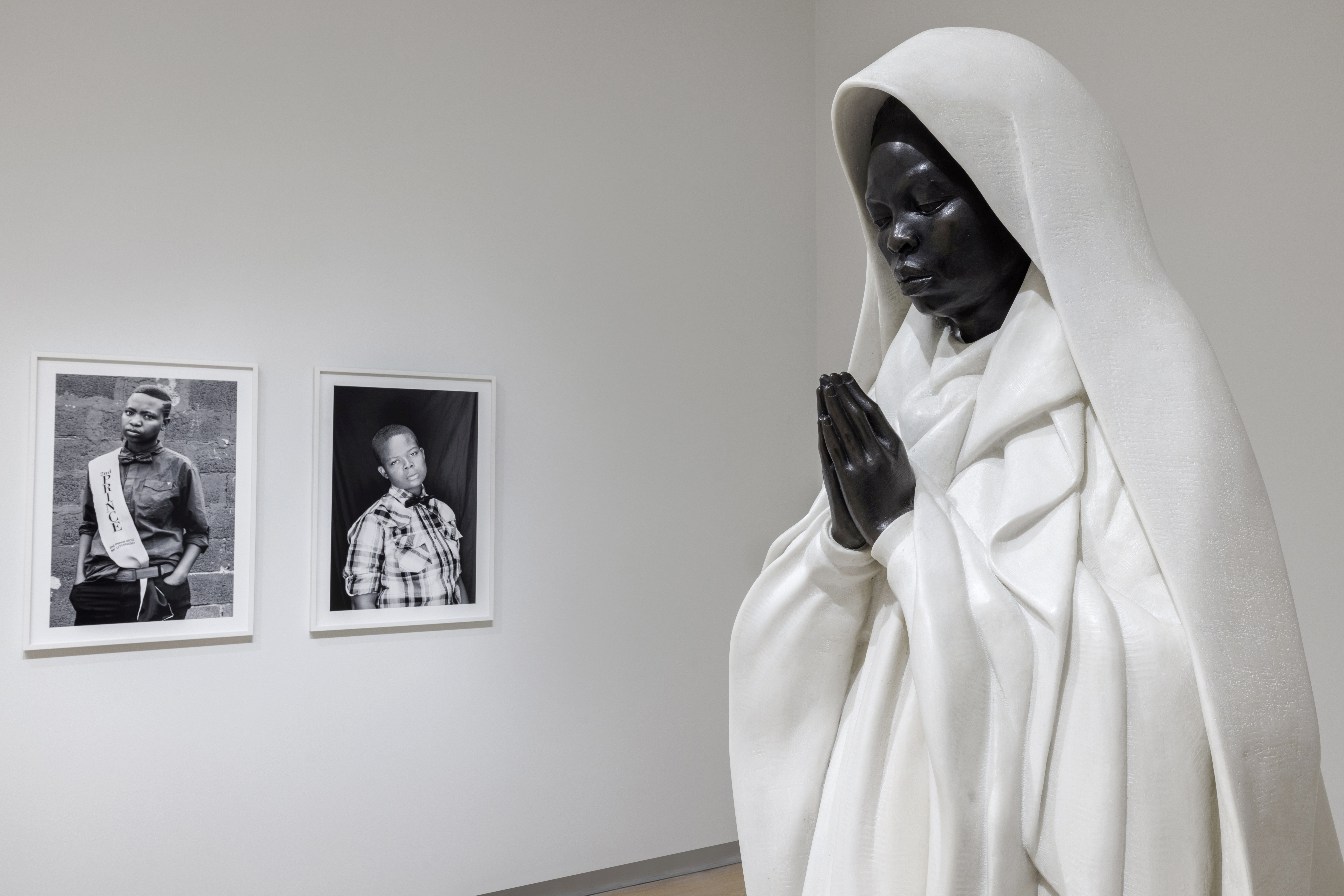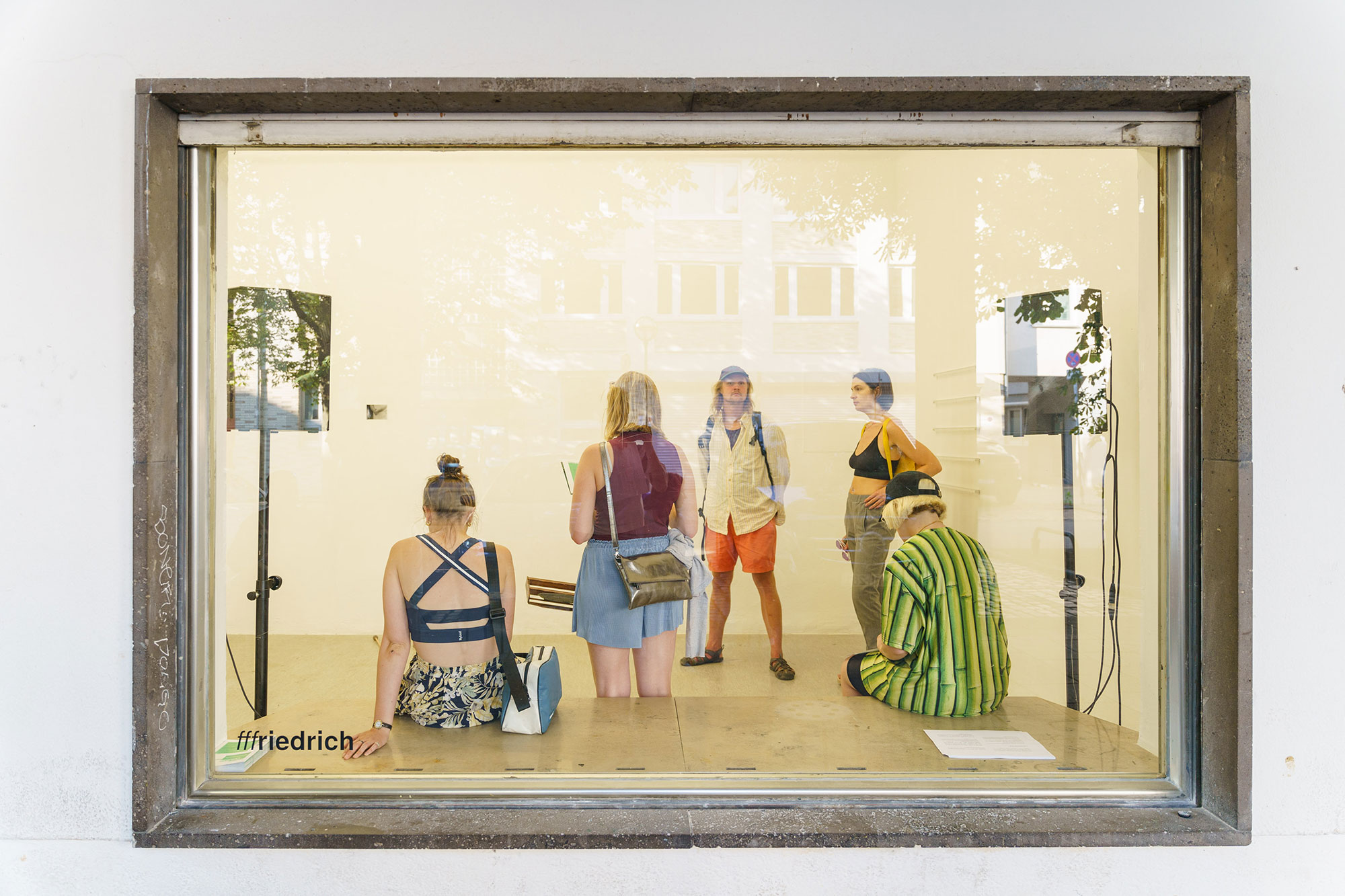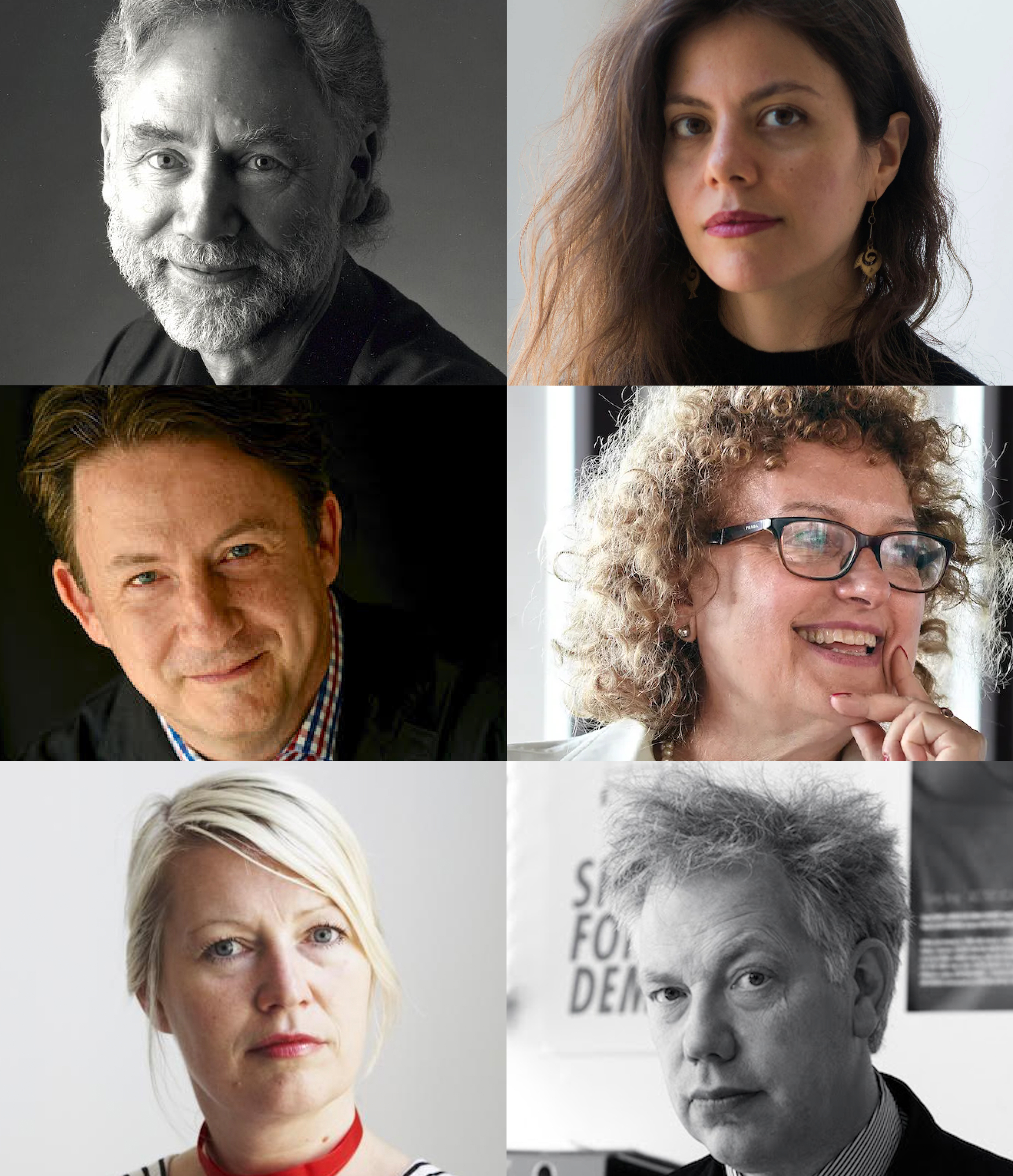https://chinati.org/
Through mid-June, e-flux Education will focus its coverage on the United States, examining educational institutions in the American South and Southwest in particular. With attention paid to the specificities of each program or institution and its pedagogies, the upcoming features will also consider the surrounding regions' dense legacies of segregation, slavery, and frontierism alongside more contemporary reformations of schooling, museology, and justice.
In conjunction with Tabitha Steinberg’s recent feature on the Blackwell School Museum, Hallie Ayres returns our attention to Marfa, Texas, to contrast a neighboring schoolhouse's museological approach.
The first time I visited Marfa, Texas, was during a high school summer, accompanying some friends who saw the town as an ideal locale to take hallucinogens. While they tripped, I walked, eventually encountering what I later learned are Donald Judd’s 15 untitled works in concrete (1980–1984)—concrete containers that pepper this tract of the Chihuahuan desert’s expansive horizon. Each constructed of four 25-cm-thick concrete slabs poured on-site, the works were the first to be installed at the Chinati Foundation, the monument to “empiricism" in the form of a museum that Judd began constructing in 1979, just two years after he moved to Marfa full-time.[footnote Judd rebuked the term “minimalism,” preferring instead to refer to himself as an empiricist. The art commissioned for Chinati and championed by Judd reflects his strident adherence to this empiricism: the belief that knowledge is derived from experience rather than from reason. In this sense, Chinati is less a paean to the minimalism concurrent with Chinati’s founding than it is a hallmark in the movement to displace art from cities and install it in nature, or at least in settings that more easily engender a precise and embodied engagement of the senses. The negative space surrounding a work of art, in Judd’s mind, is requisite to fully articulating the form of the work.]
With financial assistance from Dia Art Foundation, Judd purchased the remnants of Fort D. A. Russell, a US military installation established in 1911 to guard against the perceived threat of Pancho Villa’s encroaching revolutionary army. Until its deaccessioning in 1946, the Fort trained and housed US troops focused on the fortification of the US border. I didn’t learn any of this back then, but I was aware of an already stark difference between Marfa residents who had chosen to move there in recent years, following Judd’s path, and those whose families had lived there for generations. This difference was overwhelmingly racialized: white art-world interlopers tended to congregate in the same quarter of upscale blocks, in sleek ranch houses or trendy new breweries, while Hispanic families seemed sequestered across town.
Ten years later, I returned to Marfa on a graduate school trip. In the interim, the town, with a current population of around 1,600, had certainly become more inundated with transplants in their cowboy cosplay, donning leather boots and pricey patchwork denim.[footnote Interestingly, the current population is about 800 inhabitants fewer than the 2,466 Judd quoted in 1971, when he first decamped to Marfa. “There were few people and the land was undamaged,” he wrote of the town where he would soon construct nine-foot-high adobe walls around a full city block, swearing that it “is not pretentious, as even the best recent architecture is.” “Marfa is made mostly of adobes,” he reminds the reader, “but the town had forgotten that when I started using them.” Judd, Donald. “Marfa, Texas, 1985.” In Donald Judd: Writings, edited by Caitlin Murray and Flavin Judd, 422–30. Judd Foundation/David Zwirner Books, 2016, →.] Indeed, the commercialized spectacle of the art world had begun to breach Judd’s enclave in the early 2000s, as investors hoping to capitalize on art-world tourism poured capital into boutique yurts and curated shops that sell candles for seventy dollars. This trend crystallized in Scandinavian duo Elmgreen & Dragset’s Prada Marfa (2005), a faux store showcasing the luxury brand’s 2005 line and installed along a strip of highway some thirty miles outside of town. Conceived to critique the consumerism that was beginning to plague Marfa—with ramifications far greater, as luxury brands had begun and continue to appropriate Judd’s minimalist aesthetics—the permanent installation has become an elite signifier itself, a requisite post on celebrity Instagram profiles.[footnote Most amusingly, Kim Kardashian faced public ridicule and was sued by the Judd Foundation after the influencer claimed, in an Instagram video, that her knockoff versions of Judd’s La Mansana Table and Chair 84 were authentic. →
Entangled in this mystifying web of a desert town are two instances of schoolhouses transformed into museological installations. Purpose-built as a total installation, Ilya Kabakov’s School No. 6 (1993) occupies one of Chinati Foundation’s many former army barracks, a structure chosen by Kabakov when he first visited in 1992 precisely because of its authentic state of disrepair. Subdivided into a sequence of rooms painted in institutional beige and light green, the work evokes an abandoned Soviet schoolhouse subsumed by a retrospective Soviet melancholia. Invited by Judd to produce a permanent installation for the Foundation, Kabakov fabricated a mythological schoolhouse: a container of the sense of utopian possibility embedded in the Soviet childhood, here transformed into ruins.
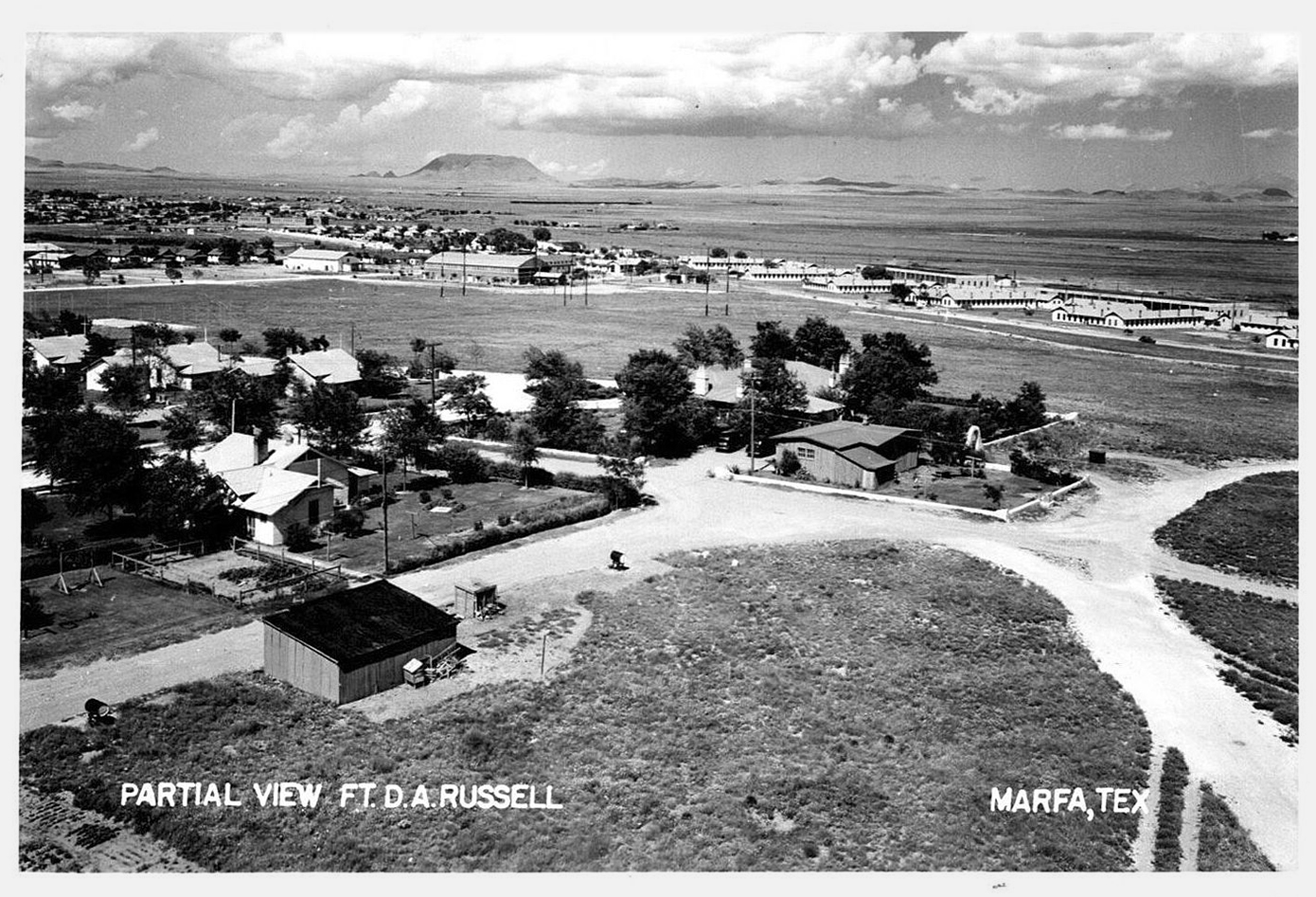
A “real photo” postcard depicting an aerial view of Fort D.A. Russell, Marfa, Texas, circa 1930. Submitted to the Historical Marker Database by William F Haenn.
In contrast to Kabakov’s facsimile, Marfa’s Blackwell School Museum occupies its original site: a cement slab with a surrounding school yard, half a mile from the Chinati Foundation, in the historically Hispanic part of town. As the town’s de facto segregated school, the Blackwell School educated Mexican-American children from 1909 until 1965, shuttering after the Civil Rights Act of 1964.[footnote The National Park Service ranger with whom I chatted on a recent visit to the Blackwell School recounted what happened next: Blackwell students were made to carry by hand their schooling materials—including their desks—the one mile from Blackwell to Marfa’s public school facility, where the town’s Anglo residents were being educated.] Upon learning that the building, disused for decades, was under threat of demolition, a group of alumni formed the Blackwell School Alliance and, in 2007, managed to secure a ninety-nine-year lease on the building. They amassed a collection of photographs and memorabilia pertaining to the school, all donated by former students, and produced makeshift displays to house these objects in situ, converting the otherwise crumbling structure into a bulwark against amnesia. In 2022, President Biden signed a bill that granted Blackwell School status as a National Historic Site, transferring maintenance and museological duties to the National Park Service, in close consultation with the Blackwell School Alliance.[footnote For a more complete history of the Blackwell School, see this text’s companion essay: Tabitha Steinberg, “Unearthing History at the Blackwell School,” e-flux Education, April 30, 2025, →] While Blackwell awaits federal funding for restorations and updates to the display, the interpretive infrastructure of the School’s museology at present retains the Alliance’s original DIY aesthetics, not yet having undergone NPS’s standardizing treatment of didactics.
The Blackwell School Museum is free and open to the public, no reserved tour required, albeit their operating hours are more limited than the Chinati Foundation’s. Despite the fact that the two sites are a mere ten-minute walk from each other, the crowd at Blackwell School is, on any given day, substantially slimmer than the one at Chinati. (Coincidentally, the latter institution held its annual Open House event on the same day that the Blackwell School Alliance staged their pivotal “Unburying Mr. Spanish” event at their 2007 reunion.) Many texts have critiqued the relationship between gentrified Marfa and the pre-existing Tejano neighborhoods, or Judd’s writings on the Southwest, which are imbued with a sort of tabula rasa mentality toward the region.[footnote See, for example, Neda Ulaby’s “Marfa, Texas: An Unlikely Art Oasis In A Desert Town,” NPR, August 2, 2012, →; Brandon Zech’s “What’s Up With Marfa?,” Glasstire, October 22, 2018, →; Barbara Purcell’s “The Art Scene: The Ghost of Donald Judd,” Salmagundi, June 2024; Judd’s “Marfa, Texas, 1985”; and Mary Walling Blackburn’s “A Politics of Tears: The Museum of Useless Efforts, Marfa, TX,” Afterall, November 5, 2008, →.] Kabakov himself was not immune to the impression of the West Texas desert as a blank canvas. In a 1995 interview with artist-curator Robert Storr, Kabakov had this to say: “When I first came to Marfa, my biggest impression was the unbelievable combination of estrangement, similar to a holy place, and at the same time of unbelievable attention to the life of the works there. For me, it was like some sort of Tibetan monastery; there were no material things at all, none of the hubbub of our everyday lives. It was a world devoid of all trivial and banal existence—a world for art.”[footnote Robert Storr, “An interview with Ilya Kabakov,” Art in America, no. 1, vol. 83, January 1995.]
The fact that Kabakov’s staged schoolhouse exists as a component of Judd’s larger occupying campaign while Blackwell’s very real schoolhouse history has remained more obscure is critical. Contrasting these two neighboring sites of pedagogy as experiments in museology illuminates the capacity of the schoolhouse itself to serve as an agent in the production of (failed) national projects: the Soviet system and a segregated Texas.
When I returned to Marfa last year, I had a chance to venture inside the Chinati Foundation. The only way to encounter Kabakov’s installation—and, indeed, much of the Foundation’s holdings enclosed behind the entry gate, which sits a stone’s throw from US Customs and Border Patrol’s Big Bend Sector headquarters—is with a thirty-five-dollar ticket on a reserved six-hour “Full Collection” guided tour. (Kabakov’s work isn’t featured on either of the less time- and cost-intensive “Selections” and “Focus” tours.) Save for a sun-bleached banner, which reads “Welcome” in Russian, installed above its doorway, the exterior of the building itself is nondescript and nearly indistinguishable from the other barracks that line the walkways at Chinati. Inside, crumbling walls boast faded posters of Lenin, empty frames, and broken instruments. Dusty, faded vitrines showcase schoolhouse relics sourced by Kabakov—weathered notebooks, sports trophies, tattered flags, clipped black-and-white photographs, and yellowing books and maps. Some of these innumerable items are accompanied by labels in handwritten script, presented as if authored by the pupils themselves. The courtyard at the center of the structure is overgrown with prairie grasses and weeds, exactly as Kabakov intended. His instructions for preserving a curated state of decay, in fact, have been an ongoing challenge for Chinati’s conservation team.[footnote See Francesca Esmay’s “Challenges of Conserving an Impermanent Permanent Installation,” in which she marks as an example Kabakov’s 1995 judgement that the installation was “‘too dirty’ and that it must have a sense of dilapidation, but not be dilapidated,” followed by a note that, in 2002, “Kabakov...states that installation is ‘too clean,’ places dirt and gravel throughout installation and on display cases.” Esmay, The Chinati Foundation Newsletter, vol. 8, October 2003.]
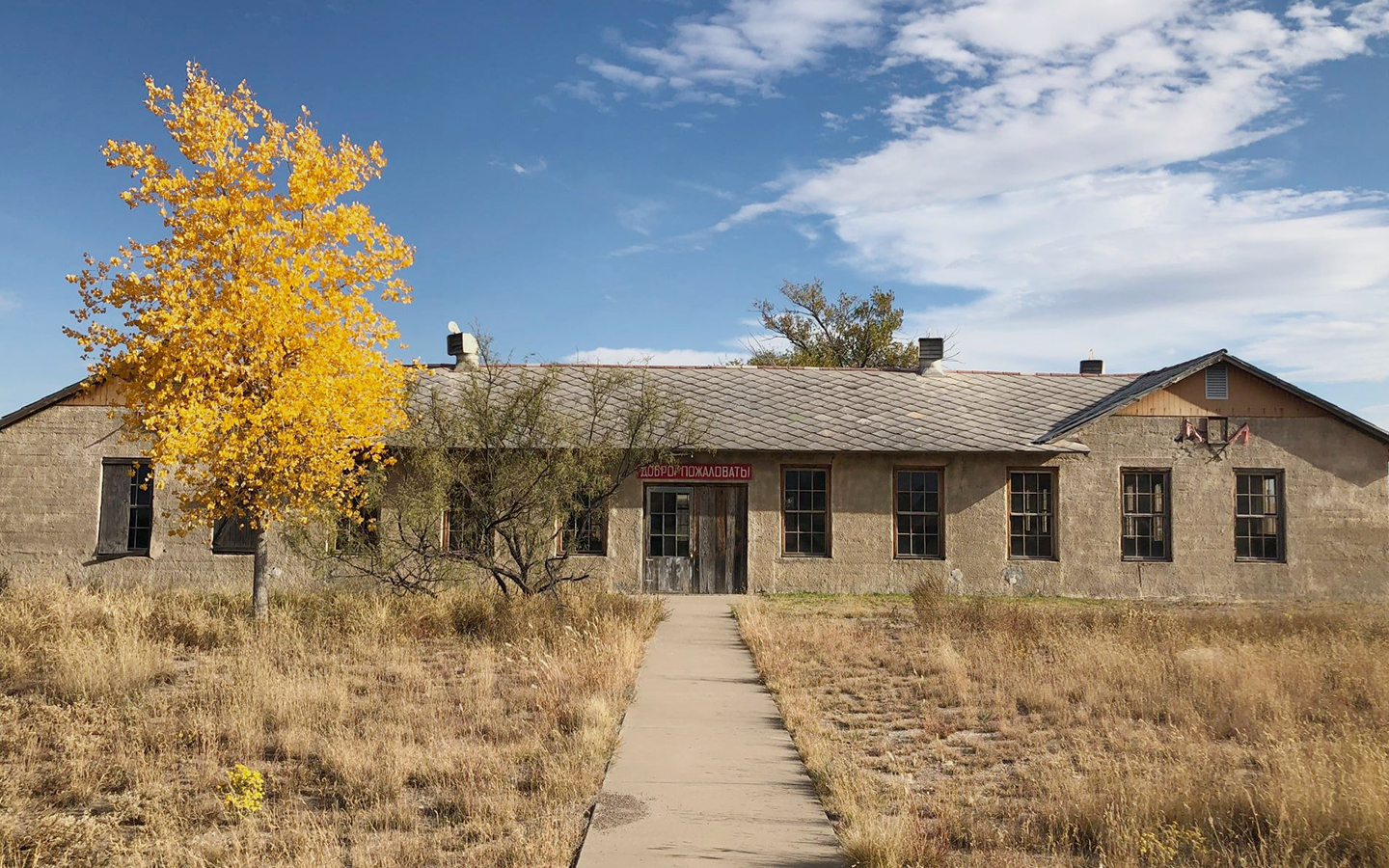
The former barracks that house Ilya Kabakov's School No. 6, 1993. Permanent installation at the Chinati Foundation, Marfa, Texas. Courtesy of the Chinati Foundation.
Within the installation, there are enough childhood-learning trappings for viewers—even those unfamiliar with Soviet aesthetic codes or cursive Cyrillic—to gain an informed impression of quotidian, Soviet village schooling: illustrated storybooks are scattered on the floor, period-accurate world maps decorate the walls, and the like. In his statement on the work, Kabakov touts the exemplary status of this fabricated provincial schoolhouse, writing that “among other schools of the region it was first place in terms of ‘progress’ and in terms of the ‘organization of the academic process.’”[footnote From the aforementioned statement on Kabakov’s website: →.] He makes clear that the school’s closure was not due to some tragedy or to a dearth of care on the part of administrators or teachers; it was simply deserted as villagers moved away until “there was no sense in having and maintaining a school in this place.” Kabakov’s description continues:
“[T]oday there is emptiness and oblivion where just yesterday there was life and voices resounded....The courtyard is overgrown with grass up to one’s waist, and there is only wind, freely blowing through the building, through the empty windows, rustling the children’s notebooks left on the floor and the announcements about lessons and old geographical maps on the peeling walls…”
During a 1981 stay in Czechoslovakia, his second time outside of the Soviet Union, Kabakov authored the brief essay “On the Subject of ‘The Void.’” In attempting to define Soviet consciousness, Kabakov claimed that Soviet life is lived on two planes: “on the plane of [one’s] relations with other people and nature, and on the plane of [one’s] relations with the void.”[footnote Ilya Kabakov, “On the Subject of ‘The Void” in Total Enlightenment: Moscow Conceptual Art 1960–1990, ed. Boris Groys, Max Hollein, and Manuel Fontán del Jundo (Hatje Cantz Verlag and Fundación Juan March, 2008), 370.] He continued:
On the level of daily life, this split, this bifurcation, this fatal lack of connection between the first and second planes is experienced as a feeling of general destruction, uselessness; dislocation, and hopelessness in everything, no matter what a person does, whether he is building or performing some other task, he senses in everything a feeling of impermanence, absurdity, and fragility. This life on two planes causes a particular neurosis and psychosis in every inhabitant of the void, without exception. The void creates a particular atmosphere of stress, edginess, debility, apathy, permanent groundless terror: that is the state of the people who live in the place where the void dwells.
Later, he declares the most apt metaphor for this voided state system to be the ceaseless wind, “blowing through and between houses, blowing everything before it, an icy wind, bringing cold and ruin, howling and smothering, always with the same continuous pressure....Just as the aim, purpose, roar, and continuous pressure of the wind are incomprehensible to the [void dwellers], so too is the state system incomprehensible, the state system with all its gusts and sudden changes of direction.”
As a state-run institution, the school bore the weight of ideologically conditioning the inheritors of the Soviet future. In describing School No. 6 as having been overtaken by nothing but wind, then, Kabakov aligns the installation with a state system that he portrays as blustery and capricious, that can stir up utopian optimism and unsettle individual consciousness within the vacuum of its day-to-day reality.[footnote Of the Soviet childhood represented here, Boris Groys writes: “The (installation’s visual material is) positive, optimistic, joyous; but this optimistic Soviet childhood is now deserted and their images are in decay....The Soviet childhood was not so much a paradise, but a utopia. It was futuristic.” Groys, “Kabakov as Illustrator,” The Chinati Foundation Newsletter, vol. 8, Oct 2003.] School No. 6 underscores these sorts of gaps, voids, and lacunae. Symmetrical on its facade are two arrangements of red flags crossing beneath a portrait frame, in the typical Soviet manner. Here, as elsewhere inside the building, the frames are empty, voiding any magisterial claim to a national history. As Boris Groys has remarked of Kabakov’s practice, “again and again, Kabakov stages the dissolution of the Soviet civilization into historical garbage.”[footnote Groys, “Kabakov as Illustrator.”]
If Kabakov’s School No. 6 is emblematic of what Groys argues in his canonical Gesamtkunstwerk Stalin (2013)—that the Soviet Union was Stalin’s total work of art, engineered by his understanding of its citizens and society as aesthetic material to be shaped according to his political ideals—then it bears some comparison to the position the Blackwell School might have historically held within Marfa and its environs. While alumni had varied experiences at Blackwell, and while some teachers were far more revered than others, the school as an entity performed its segregationist role within a racist settler state throughout an era when Texas upheld its claims to territory through brutal and often unwarranted force.[footnote Throughout the Mexican Revolution period (1910-1920), the infamous Texas Rangers–who were formed, in 1835, not only to protect white homesteaders from Comanche and Apache raids, but also to actively dispossess those tribes of their land in order for whites to continue settling it–turned their attention to the vast borderlands of the state. As peasants throughout northern Mexico started gaining rights to former haciendas under progressive reforms, those in power in Texas began to worry not only that Tejanos in the state might begin calling for an insurgency of their own but also that peasants of any ethnicity might begin to demand a similar campaign of land redistributions. In January 1915, in the South Texas border town of McAllen, local authorities arrested Basilio Ramos, a key figure in the Plan of San Diego, a plot that called for an armed rebellion against Anglos for the purpose of reclaiming Texas, New Mexico, Arizona, California, and Colorado as an independent republic that could later be annexed to Mexico. Ramos was released from jail by May, but news of the Plan had heightened racial tensions. When Mexican sedicionistas began a series of violent and indiscriminate raids on ranches and infrastructure in July of that year, the Texas Legislature responded by vastly increasing the number of Rangers on the force, sending unqualified and untrained men to all parts of the border to “patrol.” Thus began what the Rangers refer to as the Bandit Wars. Mexican-Americans, however, refer to this period of history as La Hora de Sangre (The Hour of Blood). In January 1918, one of the more insidious events during this period took place about 30 miles away from Marfa, in Porvenir–Spanish for “future”–a town that no longer exists due to the Rangers’ brutal massacres.] Blackwell School alumni made clear the extent to which they, during the original “Burying Mr. Spanish” ceremony in 1954, had been forced to serve as aesthetic material for this sort of Gesamtkunstwerk Texas: they were instructed to inter in the schoolyard a coffin inscribed with “Mr. Spanish” that they had filled with strips of paper on which each pupil had written “I will not speak Spanish.” One also recalls that Blackwell had already existed for two years when Fort D. A. Russell, later to become Chinati, was established to fortify the border.[footnote Originally incorporated to protect the US from incursions similar to Pancho Villa’s 1911 raid on Ciudad Juárez, just across the border, the Fort quickly began to focus on curtailing border crossings, for any reason. By 1924, a contingent of soldiers had become known as Mounted Watchmen and were tasked with deterring crossings.]
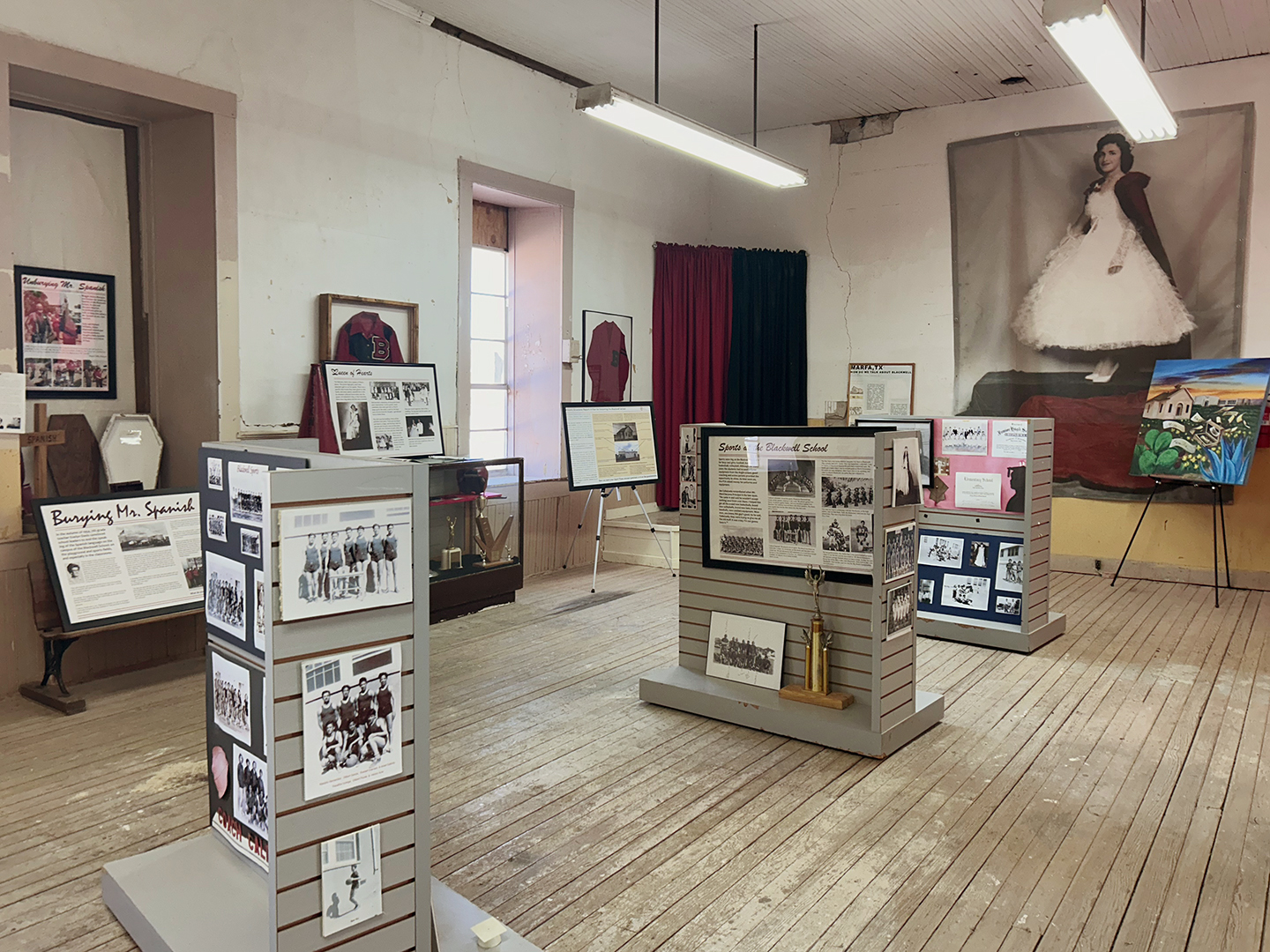
View of the Blackwell School Museum's main exhibition space, Marfa, Texas. Photo: Hallie Ayres.
Whereas Kabakov utilizes the schoolhouse to illustrate indoctrination into a top-down ideological ordering system, Blackwell’s contemporary history serves as a converse of sorts. Mary Walling Blackburn chronicles the period that led up to the formation of the Blackwell School Alliance:
[By 2007] the Blackwell graduates who had remained in Marfa had radicalized and were now asking the town to recognize its legacy of segregation and perhaps flirting with the possibility of underscoring its current bifurcation. In the weeks [preceding the Blackwell Reunion], the planning committee strategically placed matted photographs of Blackwell’s student classrooms, clubs and sports teams in the windows of businesses throughout the entire town. The images, festooned by red and black paper garlands, circulated through neighborhoods where, previously, only whites had lived, and Latinos only visited, entering homes and neighborhoods to clean floors and mend fences. The Blackwell Reunion Committee was re-imagining the surface of Marfa and employing a self-styled form of site-specific installation in the process, collapsing the time continuum in order to conjure a space where small town majorettes and football players of obvious Native American descent, and sometimes just as obvious relation to the Anglo ranch families, were as championed as their white counterparts.”[footnote Blackburn, “A Politics of Tears.”]
Over the last century, Blackwell alumni had witnessed their town become co-opted by moneyed transplants and their ideals for the desert enclave. In enacting their own impulse toward installation through this image-based intervention, the alumni claimed that their schoolhouse—and by extension their history and ties to the town—would no longer continue to service a conception of Marfa as a blank canvas for a total work of art, whose appeal comes from gaps or voids in pre-existing representation. Rather, by amassing and then housing their collections at Blackwell, the Alliance rebuts Marfa’s enduring mythos of vacancy that made the town so ripe for curatorial and commercial intervention.
The transfer of Blackwell to the National Park Service’s custodianship allows for a range of long-needed repairs and restorations. It also opens up the museological elements of the space to the graphic and scenographic design scheme of the NPS. In 2023, the Center for Land Use Interpretation, a non-profit research organization based in California, conducted a comparative study on the methodology and aesthetics of NPS’s interpretive didactics. Regarding these organization-wide standards, the Center writes:
National Parks are places where a piece of the continuous fabric of the American landscape is cut off from its surrounds, and described from within, through a network of interpretive devices, comprised mostly of signs–signs designed according to the guidelines of the Interpretive Design Center, at Harpers Ferry. These signs direct and control crowds, enhance visitor experiences, and impress the ideals and ideas of the National Park Service upon the public’s hearts and minds. Looking at the signs in a National Park is to read the story of a nation attempting to explain itself, to itself.[footnote The Center for Land Use Interpretation, “Signs and Waysides: The Sign Language of the National Park Service,” The Lay of the Land newsletter #47, Winter 2024.]
Last fall, I chatted with a Park Ranger at the Blackwell School. The ranger identified several of the most urgent renovations, pending the arrival of federal funding: fixing the leaking roof, building out a restroom for visitors, and making the museum ADA-accessible. The list went on. She also mentioned that the displays, repurposed from old school furniture, are due for an overhaul. Let us hope that the NPS’s interventions do not sever the Blackwell School from its environs. Instead, may the initiatives of the Blackwell School Alliance continue to refute Judd’s claim, in his 1985 text Marfa, Texas, that, “[In Marfa], as in most American cities and towns, there is little concern for old buildings. In Russia the past is fully remembered and in the United States it is fully forgotten.”[footnote Judd, “Marfa, Texas, 1985.”]
With thanks to Land Arts of the American West and the Vermillion family.
Judd rebuked the term “minimalism,” preferring instead to refer to himself as an empiricist. The art commissioned for Chinati and championed by Judd reflects his strident adherence to this empiricism: the belief that knowledge is derived from experience rather than from reason. In this sense, Chinati is less a paean to the minimalism concurrent with Chinati’s founding than it is a hallmark in the movement to displace art from cities and install it in nature, or at least in settings that more easily engender a precise and embodied engagement of the senses. The negative space surrounding a work of art, in Judd’s mind, is requisite to fully articulating the form of the work.
Interestingly, the current population is about 800 inhabitants fewer than the 2,466 Judd quoted in 1971, when he first decamped to Marfa. “There were few people and the land was undamaged,” he wrote of the town where he would soon construct nine-foot-high adobe walls around a full city block, swearing that it “is not pretentious, as even the best recent architecture is.” “Marfa is made mostly of adobes,” he reminds the reader, “but the town had forgotten that when I started using them.” Judd, Donald. “Marfa, Texas, 1985.” In Donald Judd: Writings, edited by Caitlin Murray and Flavin Judd, 422–30. Judd Foundation/David Zwirner Books, 2016, →.
Most amusingly, Kim Kardashian faced public ridicule and was sued by the Judd Foundation after the influencer claimed, in an Instagram video, that her knockoff versions of Judd’s La Mansana Table and Chair 84 were authentic. →
The National Park Service ranger with whom I chatted on a recent visit to the Blackwell School recounted what happened next: Blackwell students were made to carry by hand their schooling materials—including their desks—the one mile from Blackwell to Marfa’s public school facility, where the town’s Anglo residents were being educated.
For a more complete history of the Blackwell School, see this text’s companion essay: Tabitha Steinberg, “Unearthing History at the Blackwell School,” e-flux Education, April 30, 2025, →
See, for example, Neda Ulaby’s “Marfa, Texas: An Unlikely Art Oasis In A Desert Town,” NPR, August 2, 2012, →; Brandon Zech’s “What’s Up With Marfa?,” Glasstire, October 22, 2018, →; Barbara Purcell’s “The Art Scene: The Ghost of Donald Judd,” Salmagundi, June 2024; Judd’s “Marfa, Texas, 1985”; and Mary Walling Blackburn’s “A Politics of Tears: The Museum of Useless Efforts, Marfa, TX,” Afterall, November 5, 2008, →.
Robert Storr, “An interview with Ilya Kabakov,” Art in America, no. 1, vol. 83, January 1995.
See Francesca Esmay’s “Challenges of Conserving an Impermanent Permanent Installation,” in which she marks as an example Kabakov’s 1995 judgement that the installation was “‘too dirty’ and that it must have a sense of dilapidation, but not be dilapidated,” followed by a note that, in 2002, “Kabakov...states that installation is ‘too clean,’ places dirt and gravel throughout installation and on display cases.” Esmay, The Chinati Foundation Newsletter, vol. 8, October 2003.
From the aforementioned statement on Kabakov’s website: →.
Ilya Kabakov, “On the Subject of ‘The Void” in Total Enlightenment: Moscow Conceptual Art 1960–1990, ed. Boris Groys, Max Hollein, and Manuel Fontán del Jundo (Hatje Cantz Verlag and Fundación Juan March, 2008), 370.
Of the Soviet childhood represented here, Boris Groys writes: “The (installation’s visual material is) positive, optimistic, joyous; but this optimistic Soviet childhood is now deserted and their images are in decay....The Soviet childhood was not so much a paradise, but a utopia. It was futuristic.” Groys, “Kabakov as Illustrator,” The Chinati Foundation Newsletter, vol. 8, Oct 2003.
Groys, “Kabakov as Illustrator.”
Throughout the Mexican Revolution period (1910-1920), the infamous Texas Rangers–who were formed, in 1835, not only to protect white homesteaders from Comanche and Apache raids, but also to actively dispossess those tribes of their land in order for whites to continue settling it–turned their attention to the vast borderlands of the state. As peasants throughout northern Mexico started gaining rights to former haciendas under progressive reforms, those in power in Texas began to worry not only that Tejanos in the state might begin calling for an insurgency of their own but also that peasants of any ethnicity might begin to demand a similar campaign of land redistributions. In January 1915, in the South Texas border town of McAllen, local authorities arrested Basilio Ramos, a key figure in the Plan of San Diego, a plot that called for an armed rebellion against Anglos for the purpose of reclaiming Texas, New Mexico, Arizona, California, and Colorado as an independent republic that could later be annexed to Mexico. Ramos was released from jail by May, but news of the Plan had heightened racial tensions. When Mexican sedicionistas began a series of violent and indiscriminate raids on ranches and infrastructure in July of that year, the Texas Legislature responded by vastly increasing the number of Rangers on the force, sending unqualified and untrained men to all parts of the border to “patrol.” Thus began what the Rangers refer to as the Bandit Wars. Mexican-Americans, however, refer to this period of history as La Hora de Sangre (The Hour of Blood). In January 1918, one of the more insidious events during this period took place about 30 miles away from Marfa, in Porvenir–Spanish for “future”–a town that no longer exists due to the Rangers’ brutal massacres.
Originally incorporated to protect the US from incursions similar to Pancho Villa’s 1911 raid on Ciudad Juárez, just across the border, the Fort quickly began to focus on curtailing border crossings, for any reason. By 1924, a contingent of soldiers had become known as Mounted Watchmen and were tasked with deterring crossings.
Blackburn, “A Politics of Tears.”
The Center for Land Use Interpretation, “Signs and Waysides: The Sign Language of the National Park Service,” The Lay of the Land newsletter #47, Winter 2024.
Judd, “Marfa, Texas, 1985.”
